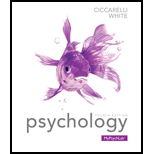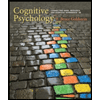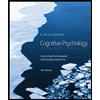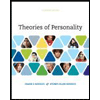
Introduction:
There are three ways to examine the cognitive development. One of the ways is found in works of Jean Piaget. He developed a theory from detailed observations of children and infants. Piaget believed that children form schemes as they experience new events and situations. Piaget proposed four distinct stages of cognitive development that occurs from infancy to adulthood: sensorimotor stage, preoperational stage, concrete operations, and formal operations.
Answer to Problem 10TY
Correct answer:
In the Piaget’s stage of concrete operations, the child become capable of understanding conservation. Therefore, option d. is correct.
Option d. is given as “concrete operations”.
Explanation of Solution
Reason for the correct statement:
In concrete operations stage which is around the ages of 7-12, a child becomes capable of conservation and reversible thinking. They are able to identify objects with respect to their characteristics. At concrete operation stage, a child is able to think logically and is very much able to understand analogies.
Hence, option d. is correct.
Reasons for the incorrect statements:
Option a. is given as “sensorimotor”.
Sensorimotor is the first stage of cognitive development, in which child uses its senses and motor abilities to learn things in its surrounding (world). Hence, it is a wrong answer.
Option b. is given as “preoperational”.
This is the second Piaget’s stages in which the child becomes capable of symbolic thinking. Hence, it is a wrong answer.
Option c. is given as “formal operations”.
Formal operation is the last Piaget’s stage in which abstract thinking becomes possible in the child. This involves not only understanding of concepts but also depth thinking regarding possibilities and impossibilities. Hence, it is a wrong answer.
Hence, options a., b., and c. are incorrect.
Concrete operation is the stage of cognitive development in which a child becomes capable of reversible thinking and conservation.
Want to see more full solutions like this?
Chapter 8 Solutions
Psychology (paperback) (4th Edition)
- ||| 13:34 0 鼷浴醵剀婴 Vo 56 5G Men & Wom... heusenindia.abfrl.in 1 your first purchase. Use Code VHGET10. 52% 52% 口: MORE BRANDS = VVAN HEUSEN Q O ADITYA BIRLA FASHIONarrow_forwardYour task is to attend a Jazz live concert, either on or off campus, and then write a comprehensive concert report based on your experience. Your assignment must be at least 700 words. Outline: 1) Introduction: 2) Description of the concert: 3) Musical Analysis: 4) Evaluation: 5) Reflection and Personal Response: 6) Conclusion:arrow_forwardYour task is to attend a live concert, either on or off campus, and then write a comprehensive concert report based on your experience. Your assignment must be at least 700 words. Outline: Here's a step-by-step guide on how to write your concert report: 1) Introduction: 2) Description of the concert: 3) Musical Analysis: 4) Evaluation: 5) Reflection and Personal Response: 6) Conclusion:arrow_forward
- 2) Describe Eysenk’s theory about the physiological basis of Extraversion and Introversion (chapter 6) and its implications for personality and behavior. Similarly, describe Petrie’s reducer-augmentor theory of pain tolerance and its implications for personality and behavior (chapter 12). Discuss the similarities and differences between these two approaches to personality (mention at least 2 similarities and 1 difference). Finally, speculate on the author’s justification for placing Petrie’s account in the chapter on Cognitive Topics on personality rather than in the chapter on Physiological Bases of Personality. Please provided all pertinent information.arrow_forward1) Define the Nature Nurture debate as it relates to personality. What is the ‘clarification’ described in Chapter 6? Select one personality trait / behavioral tendency from Chapter 6 that has some genetic basis to it and report either the correlation between the trait for twins raised apart or the heritability statistic for that trait and describe trait related behaviors (see the section “Major Findings from Behavioral Genetic Research”). Discuss the social and political implications that would probably arise from viewing that trait as a) primarily genetically determined, b) primarily environmentally determined, or c) as determined by an interaction of genes and environment (in your response, briefly consider each set of implications). Please provide all pertinent information.arrow_forwardI need help finding 16 peer-view research articles on India strong family traditions and rituals are handed down through the generations so we can understand how custom influences behaviorarrow_forward
- Can you create 3 facilitation session plans in which a school counselor facilitates a play experience with a group of children? The 3 plans should include a target group, the play media used, the 3 session titles, a description of the American School Counselor Association (ASCA) domains, the ASCA mindsets and behaviors, the purpose, session objectives, the materials, step-by-step directions for the entire session (beginning, middle, and end), and be specific and detailed enough for another school counselor to easily facilitate each part based on the information provided in the plan. Please write in narrative format and include citations and references with the appropriate website link.arrow_forwardHI Hi with this unit/ assessment PSY4406 TP4 Report assessment material case stydu Ms Alecia Moore. on google search bar it appeared the whole report was already written, including the answers, how can obtain the full version that was on preview on the google search, as i would like to use this as template to similar case study i have in my workplace report writting for future clients. As first year graduate student im looking for support in writting psychological reports. and this example layout draw my attention. your response is greatly appricatedarrow_forwardCreate a post of 150 words reflecting on the items below. Instructions: Begin by reflecting on your own experiences with music technology, including how you discover new music, your preferred listening platforms, and any notable changes in your music consumption habits over time. Discuss the impact of streaming services like Spotify, Apple Music, and YouTube on music accessibility and the way artists distribute and monetize their work. Explore the role of algorithms and personalized recommendations in shaping music discovery. How do these algorithms impact the diversity of music we encounter, and are there potential drawbacks to algorithm-driven content curation? Consider the benefits and challenges of digital music production tools for artists. How has technology democratized music creation, and what new possibilities does it offer for artistic expression?arrow_forward
 Ciccarelli: Psychology_5 (5th Edition)PsychologyISBN:9780134477961Author:Saundra K. Ciccarelli, J. Noland WhitePublisher:PEARSON
Ciccarelli: Psychology_5 (5th Edition)PsychologyISBN:9780134477961Author:Saundra K. Ciccarelli, J. Noland WhitePublisher:PEARSON Cognitive PsychologyPsychologyISBN:9781337408271Author:Goldstein, E. Bruce.Publisher:Cengage Learning,
Cognitive PsychologyPsychologyISBN:9781337408271Author:Goldstein, E. Bruce.Publisher:Cengage Learning, Introduction to Psychology: Gateways to Mind and ...PsychologyISBN:9781337565691Author:Dennis Coon, John O. Mitterer, Tanya S. MartiniPublisher:Cengage Learning
Introduction to Psychology: Gateways to Mind and ...PsychologyISBN:9781337565691Author:Dennis Coon, John O. Mitterer, Tanya S. MartiniPublisher:Cengage Learning Psychology in Your Life (Second Edition)PsychologyISBN:9780393265156Author:Sarah Grison, Michael GazzanigaPublisher:W. W. Norton & Company
Psychology in Your Life (Second Edition)PsychologyISBN:9780393265156Author:Sarah Grison, Michael GazzanigaPublisher:W. W. Norton & Company Cognitive Psychology: Connecting Mind, Research a...PsychologyISBN:9781285763880Author:E. Bruce GoldsteinPublisher:Cengage Learning
Cognitive Psychology: Connecting Mind, Research a...PsychologyISBN:9781285763880Author:E. Bruce GoldsteinPublisher:Cengage Learning Theories of Personality (MindTap Course List)PsychologyISBN:9781305652958Author:Duane P. Schultz, Sydney Ellen SchultzPublisher:Cengage Learning
Theories of Personality (MindTap Course List)PsychologyISBN:9781305652958Author:Duane P. Schultz, Sydney Ellen SchultzPublisher:Cengage Learning





